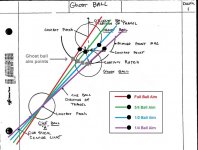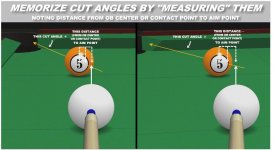Ok Duckie since years I follow all what you are saying- and you are telling nothing else but Ghostball is the only way pool can be played- I have developped two aiming methods and I do know that this game can be played in several ways- may it be with using 90/90 CTE or with the SEE-System or with SAMBA for pool which I develloped. There may be even more ways...that I don't even know about... I will play you any game (you can choose 8/9/10 ball straight pool or bank pool) and I will announce any shot with my method for any amount of money ( just choose the amount of money and we will both transfer the money to an account that the winner will be able to take it from) just to finally proove you that there are other ways to play this game at a professional level and to finally stop you from negating any other method but ghost ball- Think about it - and pm me here on AZB or just... whatever...
I will even fly to the US on my own expenses if the money will be worth it
Gesendet von iPhone mit Tapatalk
Like I give a shit....really......I don't give a shit. Does any of those methods you stated provide any info on how to adjust? What happens when changes in CB placement are needed to be made or the effect distance has on those changes?
The purpose of the drawings are not for use to aim. I made those in order to better understand what was happening. I needed a way to understand the effects of making adjustments.
Since I have never, ever, ever, ever visualized a ghostball, as this seems to be how the majority think to use ghostball, I don't use ghostball aiming. How can I be using ghostball aiming if I don't "see" a ghostball?
There is a difference in thinking between placing the CB somewhere and aiming. See I aim my pistols, I aim my rifles, I aim my shotgun. I can not say the same thing about any system in pool. In reality, there are no aiming systems in pool, just CB placement methods.
It appears that the lack reading comprehension runs great on this site. Also the inability to understand the topic being discussed. These were not posted in this thread to discredit anything, just to give some addition info about a shot using the ghostball principle .....it was YOU that has the issue.
Being able to think freely, to form your own ideas and opinions from life experiences seem to be lacking greatly also.
I'm a nuts and bolts kinda a guy......whole life. Some people just get in and drive the car.......system users, some people not only drive, but know what is going on under the hood.......real pool players.
Assuming I can't play pool is a big mistake.
Why do people continually forget about the player? It is the players application of whatever method they use and not the method used.
Would you say that someone just learning CTE or your methods will be able to apply the system as easily as a very extremely experienced user? Will the new user of CTE or your methods have the same results as a very extremely experienced user?
So, what happens if I beat you? You gonna throw out your methods and adopt mine because I just happen to be a better player? That, I just happen to be better at applying my methods than you are at apply your methods?
You gonna become a follower of Duckie?
And on the outside chance you beat me......all this mean is that I need to practice better, nothing more.
Why is this never considered.......how well a method is applied is the key, not the method being used.
In my little pool world......the opinion of keyboard warriors means very little.
You do realize all systems are based on the ghostball principle? What do your methods end up doing...........placing the CB at the ghostball position.
I just cut out all the extra steps.......I just put the CB where is needs to be without being burden with unnecessary details like what the cut angle is or where the make believe contact points/ lines are or any other subjective reference points a system requires a player to visualize in their mind.
You worry about your game and I'll worry about mine.

